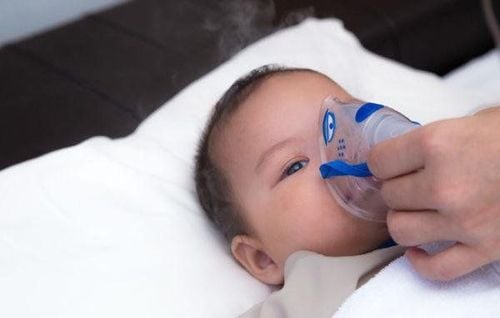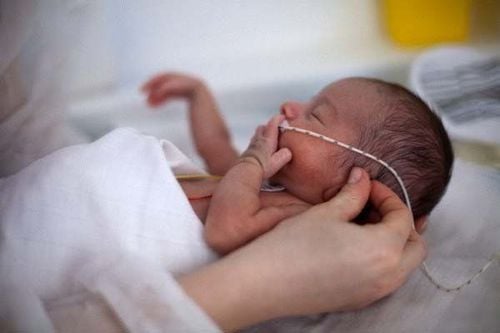This is an automatically translated article.
The article is expertly consulted by Master, Doctor Truong Thanh Tam - Pediatrician - Pediatrics - Neonatology - Vinmec Danang International General Hospital.Endometrial disease is a common disease in premature infants, when the lungs are immature, leading to severe respiratory failure. It is one of the leading causes of death in premature babies. The incidence is about 1% of all neonates and 5 - 10% of preterm neonates.
1. What is the inner membrane?
In the lungs of normal people, there is a substance in the alveoli that helps to reduce surface activity, which maintains the stability of the alveoli, and prevents the alveoli from collapsing, this substance is called Surfactant.Surfactant in the fetal lungs will appear at 20 weeks of gestation, this substance will coat the inner wall of the alveoli and be present in the amniotic fluid at 28 to 36 weeks of gestation. In premature babies, the lungs are not fully developed. Mature, unfinished surfactant.
Lack of Surfactant will cause the alveoli of the child to collapse, leading to the plasma overflowing into the alveoli, fibrin in the plasma will be deposited inside the alveoli and bronchioles forming a membrane that obstructs the air circulation. gas and oxygen exchange, at which time CO2 from the alveoli passes through the capillaries will lead to respiratory failure and can cause rapid death.
2. Causes of endocardial disease in infants
Endometrial disease is one of the most common causes of respiratory distress in neonates, often manifesting within hours or days of birth. The disease occurs in 5 - 10% of all premature babies.Statistics show that low birth weight children will have a high morbidity and mortality rate will decrease with the time of onset of the disease. The two main causes of the disease are: Premature birth and asphyxia in the uterus.
The lungs of premature babies are still immature, the permeability of the pulmonary capillaries and the alveolar membranes increases, which easily causes edema in the interstitial tissues and in the alveolar lumen. This leads to extravasation of blood cells, plasma, and fibrin into the alveoli. After the fluid is withdrawn, fibrin and some red blood cells remain in the alveolar lumen.
When the fetus is asphyxiated, the alveolar cells are deprived of oxygen, poor cellular nutrition, so the baby does not produce enough surfactant, cannot create surface tension, leading to collapsed alveoli, poor gas exchange lead to respiratory failure.
In fact, respiratory failure will appear after a short time (a few hours or days) and quickly disrupt gas exchange, air cannot diffuse through the alveolar membrane, causing the child to exert himself breathing, the child quickly becomes exhausted.

3. Symptoms of Inner Membrane Disease
History of the disease often appears in premature babies, asphyxia. The mother has medical conditions such as diabetes, genital bleeding before giving birth. Symptoms of endocarditis appear hours or days after birth, especially within the first 6 hours.Children who are breathing normally suddenly appear respiratory failure: Symptoms of cyanosis appear more and more, children breathing faster than 60 times / minute, babies born too prematurely, even breathing slowly. Children pull and pull respiratory muscles clearly: the phenomenon of chest retraction, nasal flaps rise and fall. Children groan: mainly in the exhalation. Cardiovascular disorders: tachycardia >120 beats/min. If the manifestation of endocardial disease is mild and treated correctly, after about 72 hours, the symptoms will gradually subside. If severe, the signs of cyanosis, increased shortness of breath, low blood pressure, low body temperature, the child will die after a few hours. However, children after recovering from the disease can still leave quite severe sequelae such as cerebral hypoxia, cerebral hemorrhage, hypoglycemia...

4. Treatment of endocardial disease in infants
Principles of treatment of endothelial disease in neonates Prophylaxis of antenatal corticosteroids. Exogenous surfactant. Supportive ventilation therapy Corticosteroid prophylaxis before birth Corticosteroids are indicated for use in mothers at high risk of preterm birth from 23 to 34 weeks.Exogenous surfactant Prophylaxis of respiratory failure due to endothelial disease in neonates: Early use of exogenous surfactant to prevent respiratory failure in preterm births < 27 weeks of gestation. Currently, surfactant has been actively used early for high-risk children, not waiting until respiratory failure is present. There are 2 types of Surfactant:
Natural Surfactant (from humans, pigs or cows): Survanta. Synthetic surfactant: Newfactan Route of administration Surfactant: pumped into the lungs through the endotracheal tube. The dose is from 50 to 200 mg/kg/time, depending on the severity of the disease. Repeat dose: when the patient requires FiO2 > 30% and cannot be extubated after surfactant pump. Maximum can be repeated 3 times.
Supportive ventilation therapy Breathing nCPAP (continuous positive airway pressure through the nose) to prevent alveolar collapse, helps maintain functional residual capacity, and minimizes apnea episodes. Non-invasive mechanical ventilation (NIPPV) to avoid endotracheal tube injuries. Only invasive ventilation is available when an infant has one of the following three criteria:
Respiratory acidosis: pH < 7.2 and pCO2 > 60 mmHg with nCPAP. Hypoxia: PaO2 60mmHg with nCPAP. Prolonged pauses in breathing. In order to prevent endocarditis in newborns, pregnant women must ensure their health and proper nutrition, scientific activities, and labor. It is necessary to have regular check-ups and pregnancy monitoring to prevent premature birth or low birth weight babies.

Master. Truong Thanh Tam has 15 years of experience in pediatrics and especially has a lot of experience in hematology, resuscitation and pediatric oncology. The doctor has participated in many national and international scientific conferences on pediatrics and participated in many short-term training courses and was certified as "Pediatric Core Instructor", by Hue University of Medicine and Pharmacy. grant. Currently, she is a Pediatrician at the Department of Pediatrics - Neonatology - Vinmec Da Nang International General Hospital.
Please dial HOTLINE for more information or register for an appointment HERE. Download MyVinmec app to make appointments faster and to manage your bookings easily.














